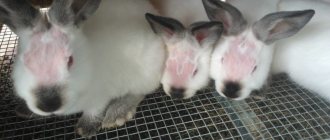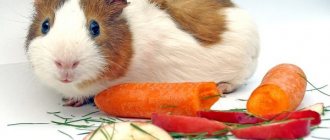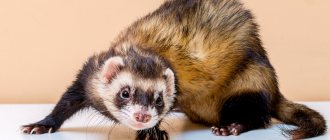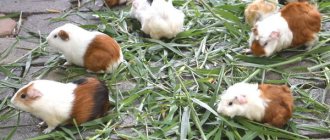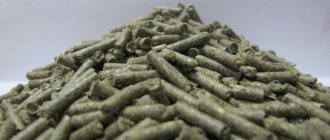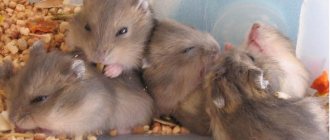Poor nutrition
Their further development depends on how young offspring are fed, which is important for obtaining healthy offspring in the future from sows and meat for nutrition. Quite often, problems with food consumption arise due to an incorrect diet.
Lack of balance
An incorrectly composed diet, in which monotonous food is present for a long time, contributes to indigestion. This is especially true for coarse feed, which the digestive system cannot yet fully digest.
It is important to feed piglets food rich in vitamins, minerals, carbohydrates, fats and proteins. If at least one element is missing, the pigs begin to get sick, as a result of which they refuse food.
The disorder manifests itself as:
- diarrhea or constipation;
- nausea and vomiting;
- apathy (lack of activity);
- drowsiness.
To prevent this from happening, provide 2-3 types of food per day and provide constant access to plant foods, which should act as a supplement. If it is difficult to balance your diet on your own, purchase special food, but this will be expensive.
Avitaminosis
When a pig refuses to eat and does not gain weight, this may indicate vitamin deficiency. This is especially true for vitamin D, which is very important in young pigs.
A lack of elements leads to a variety of consequences, but there are substances, in the absence of which the animal not only refuses to eat, but also leads to the following problems:
- vitamin D – rickets, developmental delay;
- vitamin A – digestive and respiratory problems;
- B vitamins – growth retardation, diarrhea, diseases of the cardiovascular system;
- iron – anemia.
As mentioned above, the most dangerous is a lack of vitamin D, since against this background the following occurs:
- deformation of joints and bones;
- weight loss;
- unsteadiness;
- lethargy;
- convulsions in the limbs.
To solve the problem, it is necessary to introduce into the diet such products as cow's milk (in no case store-bought), whey, blood or meat-and-bone meal, and fish oil.
To prevent vitamin D deficiency, do the following:
- In summer, late spring and early autumn. Provide the animals with a full run outside and always in the open air so that the rays of the sun fall on the skin of the piglets.
- In winter and during periods of rain and cold. Install ultraviolet lamps in the pigsty. Irradiate them daily for 5-10 minutes.
- Injections. If it is not possible to perform the above actions, vaccinate against rickets or give injections with vitamins.
Fungal infection of feed
If the food is contaminated with fungal spores, the release of mycotoxins begins, which causes ulcers to form on the mucous membranes and skin of the animal. Accordingly, the piglet will not be able to fully take food into its mouth and chew it due to unbearable pain.
In addition, contaminated food has an unpleasant smell and taste (such as mold), so the pigs’ appetite disappears.
How to correct the situation if there is a lot of such food in the bins:
- 1-2 days before feeding, dry the food under the scorching rays of the sun or in the oven, but it is best to do a similar manipulation with all available food, since the spread of the fungus is rapid;
- include a mycotoxin sorbent in the feed mixture, which destroys the fungus;
- treat with feed acidifiers.
Too dry and too wet food
The digestive tract of piglets is not fully formed - it is tender, unstrengthened, and therefore is not able to process excessively dry or wet food.
Other causes and symptoms:
- Dry. Dust is released, which penetrates the lungs and respiratory tract, which contributes to the development of bronchopneumonia. As a result, severe shortness of breath occurs, which interferes with eating food.
- Wet. The pig’s body’s defenses are aimed at removing excess fluid, which is why the brain centers impulsively give a signal about this, which in turn indicates the end of the food absorption process, so the piglet does not eat for a long time (until all the moisture is removed). Considering that the animal also drinks water, this does not happen immediately.
You can add molasses or fat to dry food.
Oversaturation of feed with minerals and vitamins
Not only vitamin deficiency negatively affects appetite, but also an excess of vitamins and micro- and macroelements. Refusal to eat is a protective reaction of the piglet’s body against the intake of excess substances.
The pig feels fine, he just doesn’t eat anything. To solve the problem, you need to change the food.
Spoiled feed
If vegetables, fruits, grains, trash, etc. have signs of spoilage (rot, etc.), then they emit unpleasant odors that do not attract attention, but rather scare away animals.
The solution to the problem is the simplest - do not feed spoiled foods.
Lack of growth: what to do
The right thing to do is to call a veterinarian who will identify the problem and explain how to fix it. But good doctors specializing in the treatment of farm animals are in great short supply today. Most only practice servicing dogs, cats and other pets.
Important! If you can’t find an experienced veterinarian, you’ll have to act on your own.
Veterinarian examining a piglet
Worm infestation
Worm infestation is a common cause of slow growth. Parasite eggs enter the intestines when piglets rummage through garbage or manure. Newborn babies can receive a “gift” from a sow if she has not received prophylaxis against worms.
For the treatment of anthelmintic infestation, drugs such as Ivermec, Nilverm, Albentabs-360, Biomectin are suitable. The dosage of anthelmintics is calculated strictly according to the weight of the animal.
You can use home remedies. Chopped garlic helps a lot if you periodically add it to food at the rate of 1 g per 1 kg of weight. Another anthelmintic - tansy - can be bought at the pharmacy. Tansy flowers are ground and given to piglets along with food. 1 tsp is enough. for an animal weighing up to 30 kg, and 1 tbsp. l. for pigs weighing up to 70 kg or more. Treatment is carried out every other day, for 1-2 weeks.
The medicine is given in the morning. During the day, the room is thoroughly cleaned, and contaminated manure is disposed of. It should not be used to fertilize the garden. It is better to pour a flammable mixture over the manure and burn it. After cleaning the room, the cracks in the floors are treated with bleach. If this is not done, there is a risk of reinfection.
Attention! Home remedies help as a preventive measure and for low-grade infections. If there are a large number of worms, it is better to use veterinary medications. Preferably in injections to achieve maximum effect.
Treatment of worms in a piglet
Unbalanced diet
Little piglets need protein. If there is a lack of it, animals do not gain weight well. An irreplaceable source of amino acids are crushed grain mixtures with the addition of meal, pea flour, and cake. If you supplement this mixture with a vitamin and mineral supplement specifically designed for pigs, you get a well-balanced diet. You can prepare the grain mixture yourself or purchase ready-made feed on sale. At the beginning of fattening, the piglet is fed 1 kg of feed mixture, at the end - 3.5 kg per day.
Diseases
This is the most common reason for piglets refusing to eat. Their body acts in the same way as a human, so their appetite decreases or completely disappears. Diseases can be infectious (the most dangerous) and non-infectious.
Worms
When affected by infestations, the animal’s appetite does not always increase; most often it disappears against the background of a general deterioration in health. You can recognize a worm infestation by the following signs:
- increased anxiety;
- insomnia;
- rubbing the tail area against other objects (trying to scratch);
- sneezing, coughing, hoarse grunting - if the nasopharynx is affected;
- sudden weight loss;
- increased body temperature;
- hoarseness of voice.
Pigs do not always behave calmly; in rare cases they become aggressive, even to the point of attacking humans and biting.
Parasites can be found in feces. Antiparasitic drugs are used for treatment. The choice of a specific product depends on the age of the piglet and the type of helminths.
What you need to do:
- separate a sick pig from healthy individuals;
- carry out anthelmintic treatment of the remaining piglets;
- disinfect the pigsty, feeders, dishes, working tools, etc.
Edema disease
Most often it occurs immediately after weaning babies from the sow. Since the nervous system is affected, it manifests itself with specific symptoms:
- a sharp increase in body temperature;
- paralysis in the limbs;
- swelling of the eyes;
- swelling of the head and sternum area;
- loud squealing due to pain.
If you do not contact a veterinarian in a timely manner, the animal will die.
Plague
It is considered a deadly disease that rapidly spreads throughout the herd. The infection is transmitted not only through animals, but also through flies, insects, birds, rats, tools, and the owner’s clothes, therefore, when plague is detected, complete disinfection is carried out.
Piglets affected by the plague are destroyed.
The plague can be African and classical, and is not detected for 7 days. The causative agent is a togavirus that secretes ribonucleic acids that accumulate in the liver, bone marrow and blood vessels.
Within a short time, internal organs and systems are destroyed, causing the animal to die. How does it manifest itself, other than lack of appetite:
- increased body temperature;
- lethargy;
- vomit;
- the formation of purple-red spots in the head, ears, and thighs.
Smallpox
A viral pathology that is not transmitted to humans. After infection, the piglets' body temperature rises, formations are found on the mucous membranes and skin. Against this background, the animals become weak and completely refuse to eat.
To solve the problem, you need to contact a veterinarian who will prescribe special ointments and cauterizing solutions.
Erysipelas
Erysipelas is a disease identical to the plague, manifests itself with the same symptoms, and is dangerous. The difference is in the location of the violet-red spots - with erysipelas, they form on the soles of the hooves.
Unlike plague, piglets recover in 8-15 days.
Swine flu
The disease is not considered dangerous, since piglets do not die from it, but are difficult to tolerate, so it is important to use drugs aimed at eliminating symptoms and strengthening the immune system to alleviate the condition.
How it manifests itself:
- refusal to eat can be partial or complete;
- the piglet sneezes and coughs all the time;
- redness appears throughout the body;
- Mucus discharge flows from the nose and eyes.
The veterinarian will definitely prescribe antibacterial therapy.
Dysentery
The pathology is very dangerous for small piglets, as most often they die. Animals abruptly refuse food because their body temperature rises too much. Mandatory signs are diarrhea, drowsiness, weakness.
If urgent measures are not taken (antibacterial treatment), the piglets will die within 4-5 days.
foot and mouth disease
It is considered a serious disease with a very severe course, especially for young animals. In piglets, the skin and mucous membranes become inflamed and watery blisters form on them. For this reason, animals cannot eat food.
Treatment is relevant only in the first 2-3 days of infection, but most often the pigs die.
Rabies
This is a viral pathology that is dangerous not only for animals, but also for people, but only if a person is bitten by an infected piglet. The spread is rapid, the incubation period is from 3 to 8 weeks.
Symptoms manifest themselves as follows:
- complete refusal of food, as it is painful for the piglet to swallow;
- aggressiveness of the animal;
- increased salivation;
- unsteadiness of gait.
Death occurs about a week after the first signs appear. A harbinger of death is paralysis.
Aujeszky
Another name is pseudorabies, which is fatal for young animals. For adults, the disease is not dangerous, as it is easily treatable.
Symptoms:
- first the body temperature rises;
- then lethargy appears;
- then appetite gradually worsens;
- the piglet begins to sneeze occasionally and completely refuses to eat;
- At the last stage, convulsions appear.
To prevent the development of the disease, preventive vaccination is carried out.
Vesicular exanthema
The disease is characterized by skin rashes and increased body temperature. Incubation – from 12 hours to 14 days. It is especially difficult for young animals. Vesicular exanthema manifests itself in stages:
- Primary. The animal has a fever, so it cannot get up. At the same time, too much saliva is released from the mouth, which prevents him from eating food. During the same period, a rash forms in the area of the patch and lips. The rashes are yellowish and crusty. After their appearance, the temperature drops sharply.
- Secondary. Acne spreads to the hooves (the area of the corolla and between the toes). The pig completely refuses any food and begins to limp.
Only antibiotics are used for treatment.
Non-communicable pathologies
Among the non-dangerous diseases in which piglets do not eat anything are the following:
- Gastroenteritis. The pancreas and stomach are affected, so pigs experience severe pain, which is why they refuse to eat. Against this background, a sharp decrease in body weight occurs.
- Encephalomyelitis. The second name is Teschen's disease. The brain is affected, causing constipation, hyperthermia and convulsions. Most often, young animals cannot survive the disease.
- Salt poisoning. The main reason is too much salt in the diet. The main signs are that the animal is constantly thirsty, the temperature rises, and chills appear.
In all cases, it is recommended to immediately call a veterinarian and conduct a thorough examination to promptly identify dangerous pathological abnormalities.
Newcastle disease in broilers
A very dangerous disease, especially for the hybrid breed - broilers. As a rule, after infection, mass death of the entire livestock is observed in a short time. An infectious disease is rapidly transmitted from sick birds to healthy ones.
Among the main signs of the disease the following symptoms are observed:
- Chickens eat very poorly.
- They cannot orient themselves in space.
- They sneeze and cough frequently.
- They try to regurgitate the mucous mass stuck in the throat.
- They practically do not react to external stimuli.
- Strange sounds are made, similar to the cawing of a crow.
- Damage to the nervous system leads to the development of paresis, convulsions, spasms, paralysis, and damage to the entire body.
- The comb and beard take on a bluish tint.
Against the background of the problem, another disease develops: keratoconjunctivitis. Young broilers, instead of gaining muscle mass, on the contrary, lose weight, become weaker and are severely delayed in development.
There is no treatment for this disease in broilers and chickens, as well as other poultry! Why? Effective therapy has not yet been developed... The disease leads to the death of all birds.
The only method to avoid the problem is to carry out preventive measures.
Violations of containment conditions
Young pigs require special environmental conditions, as they react strongly to temperature changes, which leads to diseases and other abnormalities. Conditions of detention are also important. If they are not favorable, the piglets refuse to feed, breathe heavily, and develop slowly.
Pay attention to the factors that contribute to this:
- increased humidity or dry air;
- unsanitary conditions that are created due to infrequent cleaning, lack of clean feeders and drinking bowls (in addition, this entails infection);
- too hot or cold.
What to do to normalize conditions of detention:
- wash the dishes from which the piglets eat and drink;
- clean the room twice a day;
- make grooves and slope the floor to drain urine and feces;
- make sure that slurry does not fall into the feeders;
- regulate the temperature - optimal for young animals in summer from +20⁰С, in winter - at least +13-15⁰С (if necessary, install heating or cooling devices);
- ventilate the room, as feces release ammonia;
- lay straw flooring;
- in winter, to prevent freezing, raise the floor covering to a height of 15-20 cm.
Main causes of death
When breeding rabbits, farmers may face mass mortality or the death of one animal. There can be many reasons for such problems. The main factors include lack of care, use of low-quality feed, unsanitary conditions, and water pollution. Violation of the conditions of keeping animals increases the likelihood of infection by infectious and non-infectious pathologies.
To avoid mortality and reduce the number of sick animals, it is recommended that you familiarize yourself with the main rules and conditions for keeping rabbits
Studying the symptoms of diseases is of no small importance. This will help provide timely assistance to animals.
VGBK (fever)
This is one of the most common pathologies. The disease spreads through airborne droplets, feces, and contaminated foods. The pathology can have an acute or asymptomatic course. Most often, animals become infected in the summer. A day after infection they die. There are no effective treatment methods. To prevent a rabbit from dying from VGBV, it needs to be vaccinated. The first time the vaccination is given at 1.5 years, then repeated at intervals of 6 months.
Expert opinion
Zarechny Maxim Valerievich
Agronomist with 12 years of experience. Our best country expert.
Ask a Question
If the animal died suddenly, an autopsy must be performed. Otherwise, there is a risk of losing the entire livestock.
Myxomatosis (distemper)
This is a dangerous pathology that is transmitted by airborne droplets. It can also be spread through insect bites. A nursing rabbit can infect her rabbits through her milk.
At the initial stage, the disease is asymptomatic, after which bumps form on the head and ears. The duration of the disease is 1-2 weeks. Then the rabbits die one by one. There are no effective treatments. Vaccination helps prevent the disease.
Pasteurellosis
This is a viral infection that is transmitted through the air, through food or water. In this case, coughing, breathing problems, and sneezing appear. The rabbit's appetite worsens, its temperature increases, and pus comes out of its mouth.
Is it possible to give apples to rabbits and how to do it correctlyRead
If you do nothing, there is a risk of the animal dying. Antibacterial agents and sulfonamides will help cope with the problem. If you help the rabbit in time, it will survive. For prevention, vaccination is carried out from the age of one month. Adult animals must be vaccinated 2 times a year.
Coccidiosis
The causative agent of the disease is considered to be coccidia, which provokes damage to the liver and intestines. Infection occurs through low-quality food, contaminated water and feces. Distributors are people and animals.
A sick rabbit experiences decreased appetite, weight loss, bloating, and diarrhea. To prevent the animal from dying, it needs to be given antibiotics. For prevention, it is worth adhering to the rules of hygiene and disinfecting cells. It is recommended to burn dead animals.
Flatulence
The animal may die from intestinal bloating. Rabbits are characterized by high sensitivity of this organ. The cause of the pathology is considered to be a sharp change in the digestive microflora. This is due to high humidity and juiciness of products.
The main signs of flatulence are apathy and loss of appetite. As fermentation develops in the intestines, its walls swell. As a result, bacteria accumulate in the esophagus, its walls are destroyed, which leads to the death of the animal.
Stomatitis
With this viral infection, there is a strong production of saliva, the tongue swells, and the mucous membranes of the oral cavity turn red. The rabbit also experiences general weakness and a sharp decrease in weight. Treatment is prescribed by a veterinarian. If you do not help the rabbit in time, this will provoke its death.
Cysticercosis
The provoking factor of the pathology is infection of the rabbit with cestode larvae. They affect the liver and cause the development of peritonitis. It is impossible to cure the pathology. It provokes the death of the animal. The disease can only be detected after death. Dead rabbits have to be burned.
Tularemia and listeriosis
Rats, bedbugs, and ticks are considered carriers of diseases. Pathologies cannot be treated. They can be diagnosed only after opening. In this case, the carcasses of dead rabbits must be burned.
Stress
The nervous system of pigs is very sensitive, so external factors can have a negative impact, causing shock and stress. This condition, in turn, leads to decreased appetite and sudden weight loss.
What can scare a piglet:
- changing of the living place;
- change in diet (sharp);
- vaccination;
- the appearance of new animals in the pen, especially if they are not pigs (for example, cats, rats, chickens, kids, etc.);
- entering a pigsty of strangers;
- too bright or insufficient lighting;
- sudden changes in temperature.
Those individuals who are transferred from breastfeeding to full-fledged food are especially strongly affected by such factors, especially considering that the transfer itself is already stressful.
In this situation, to eliminate stress and improve appetite, various essential oils are added to the food (consult your veterinarian), and large areas for walking and playing are organized.
Why do piglets chew each other?
Also check out these articles
- How to plant eggplant seedlings
- Cabbage for the winter in jars
- Strawberry variety Albion
- Vladimir cherry
Very often, in the case of a large group of animals, they gnaw each other. Aggression in piglets is also observed due to violations of sanitary standards in the pigsty and on the run. In order for the problem to disappear, it is necessary to first expand the pigsty so that there is enough space for all individuals, but also begin to maintain cleanliness in the room.
In addition, a premix containing potassium, calcium, iron and other minerals is added to the food of young animals. Due to their lack, pigs can also start gnawing each other.
Very often, in the case of a large group of animals, they gnaw each other
Malocclusion
A piglet will not be able to chew food (especially hard food) normally if it has an overbite. In this case, he does not completely refuse food, but consumes several times less food. Due to poor digestibility, the animal begins to lose weight.
If it is not possible to show the piglet to a veterinarian, examine the jaw yourself:
- Part his lips so that all his teeth are exposed.
- Examine them carefully. If the teeth are located at the same level, this is normal, but if there are shifts of at least 5 teeth, this is considered a flaw.
The little piglet is not eating anything, lying down: what to do, how to treat it?
There can be many reasons why a pig stops eating. Some of them are absolutely not scary and do not require any action from the pig farmer. According to reviews, when a piglet experiences stress, it may refuse food.
An important diagnostic sign is whether the piglet drinks water. If yes, no need to worry. Most likely, this is a normal reaction to an irritant, and not a serious illness. After a few days, the animal will get used to the new place and its appetite will return. The livestock breeder needs to monitor the pig and consult an experienced veterinarian.
Any irritant can cause anxiety in a pig, for example:
- dog attack;
- sharp sounds;
- transportation of the animal;
- change of pigsty;
- a sudden change in diet.
According to reviews, a pig can be in a stressed state for 2–3 days. The farmer can help the animal adapt faster. To do this, they continue to give him the usual food, place him in a quiet, warm closed room, and give him enough clean water.
Diagnosis of the problem
Impaired appetite is the first sign of a deterioration in the general condition of animals. The second is lethargy and apathy. In such situations, you need to urgently call a veterinarian and conduct an examination - take tests (feces, urine and blood) to identify infectious diseases that pose a particular danger to life.
If this cannot be done, transfer sick individuals to a separate room and constantly monitor them. If signs of disease are detected, you can call not a veterinarian, but a special service that is available in any agricultural organization.
You can diagnose problems not related to pathologies yourself:
- measure the air temperature;
- determine the humidity level;
- examine the condition of the food (whether it is spoiled);
- change the type of food;
- add mineral and vitamin supplements to your diet.
Erysipelas
Erysipelas is an infectious disease that occurs acutely or chronically in the form of enzootic outbreaks, with symptoms of septicemia in the acute form and symptoms of endocarditis, polyarthritis and skin necrosis.
Another name is erysipeloid. The causative agent of erysipelas in pigs is a certain type of bacteria that lives in soil. For this reason, the disease is seasonal, most often occurring in the warm season. The symptoms and treatment of erysipelas in pigs are quite similar. However, let's consider everything in order.
The main signs of erysipelas are:
- skin rashes resembling hives;
- increase in body temperature values;
- decreased appetite;
- general weakness;
- strong thirst.
Sometimes these symptoms of erysipelas can be accompanied by a gag reflex and stool disorder in the form of diarrhea.
Transmission routes
Transmission factors for the pathogen include meat products and offal obtained from pigs with erysipelas, as well as feed, water, soil, manure, and care items contaminated with erysipelas bacteria. Within a pigsty and a small settlement, mechanical carriers of bacteria can be house flies and autumn burner flies that feed on the blood of animals with erysipelas.
Treatment
Successful treatment of erysipelas in pigs lies in identifying the disease in the early stages. Currently, there is a special vaccination against erysipelas, which, in case of infection, is used together with antibiotics of the penicillin group in loading doses. Simultaneously with the treatment of erysipelas in pigs, it is important to prevent the spread of the disease to the entire population.
Considering the above reasons for poor appetite and lack of growth in piglets, the unpleasant consequences of pig farming can be prevented. With proper maintenance and feeding, it becomes possible to develop a fairly profitable business.
How to make food attractive to pigs?
If the reason for refusing food is the monotony of food, but the farmer does not have the opportunity to replace it, you can use a trick by making it attractive to animals. For example:
- add sugar, salt or lactic acid (e.g. milk, whey) to food;
- add spices – mustard, herbs;
- instead of raw grain, cook porridge or steam it;
- yeast the feed - add baker's yeast;
- drop a little essential oil (any kind, but first check how a particular pig reacts to a certain aroma);
- If the young animals are still breastfed, add essential oils to the sow's food (the smell and taste are transmitted through the milk).
Pigs are very fond of salty, bitter, sweet and sour “dishes”.
In order for a piglet to grow healthy and massive, it needs to eat properly, so keep a close eye on each individual and pay special attention to how intensively they absorb food. If he chews slowly, picks too much, etc., then this is a clear sign of an impending nutrition problem.
0
0
Copy link
Unbalanced diet
Feeding an animal only grain food or dry food can lead to loss of appetite, so piglets need a balanced diet. Their food requires the presence of a rational amount of proteins, fats, and carbohydrates.
Experienced livestock breeders supplement the mash with chopped alfalfa, clover, and carrots. An excellent addition to food are beans, meal, cake, and baker's yeast, which are rich in proteins and amino acids and promote the rapid growth of babies. Root vegetables necessary for the growth of young animals should be present in the menu in raw and chopped form, and potatoes - boiled or steamed.
The lack of certain minerals in the body, for example calcium, can also cause poor appetite. To replenish it, it is recommended to add calcium phosphates, bone meal, and chalk to the botvinya.
Attention! The correct feeding regimen is of great importance. Up to three months of age, piglets should be fed five times a day; for older pigs, four feedings are sufficient.
Another important nuance: poor appetite in piglets can also be caused by a sudden change in feed, therefore, changing the diet must be carried out gradually and moderately.
And don’t forget: drinking bowls should always be filled with fresh and clean water.
Feeding the sow after farrowing
Adding Essential Oils
Adding essential oils is another way to make feed more attractive to pigs. This method is especially effective when used for feeding weaned piglets. After farrowing, the sow is fed food to which various aromatic oils are added. The milk that piglets suck acquires this smell.
Piglets are more willing to eat food to which grinded grains from roasted grains, as well as boiled grain, are added. After heat treatment, it smells pleasant and is also better absorbed.
If a pig begins to eat poorly, there is something to think about. The reasons need to be looked for not only in the illness of the animals - it is worth analyzing the conditions in which they are kept and how tasty and varied the menu is offered to them.
- November 21, 2018
- in Pig
- Alexey Viktorovich
Obtaining healthy offspring of pigs is the result of careful care of pregnant queens. In a private farm, it is easier to create suitable conditions, since there are never many animals in a pigsty.
In large breeding farms, for the maintenance of pregnant sows, technology is selected that meets the requirements of breeding and increasing the number of pigs. Particular attention is paid to the norms and diet of feeding during pregnancy and after farrowing.
When it's time to farrow, the pigs' diet changes. The mother needs to feed her newborn babies, who receive the necessary vitamins and microelements in breast milk. At the same time, livestock breeders ensure that the sow does not lose weight and constantly maintains lactation levels.
It is difficult to keep piglets alive and healthy after birth without mother's milk. The suckling period in sows lasts from the birth of their babies until they are weaned. The time for feeding piglets with milk ranges from three weeks of age to 60 days.
To ensure that the milk contains all the necessary nutrients for babies, the pig is given a special feeding ration after farrowing. What to feed a sow to produce more milk?
- Firstly, feeding should be wet - mash with the addition of chopped root vegetables and herbs;
- Secondly, suckling queens are fed 3 times a day;
- Thirdly, up to 5 liters of skim milk or 400 g of meat or fish waste, as well as excrement from legumes and grain crops, are added to the daily diet for increased lactation.
After feeding, the pig must be given a drink and then released for a walk. In winter, walks begin on the 5th day after farrowing. In summer, the female walks with the piglets. The suckling sow should not be shouted at or chased around the pen.
Due to stress, the animal loses milk and does not feed the piglets. The pigsty is kept clean so that the teats are not smeared with manure. In the summer, a nursing pig's udder is washed and massaged.
Feeding chart for sows after farrowing
